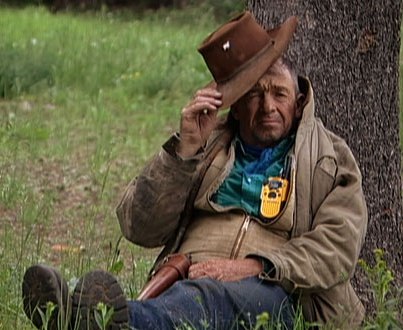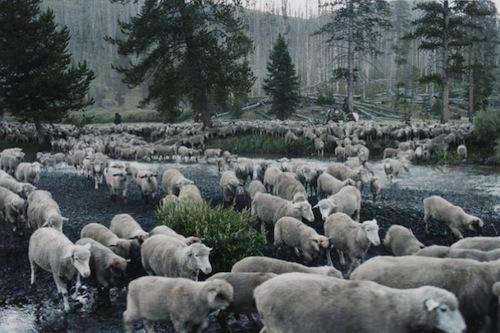The monumental documentary Sweetgrass captures the back-breaking final sheep drives by the herders of the Raisland-Allestad Ranch, Montana, into the vertiginous heights of the Absaroka-Beartooth Mountains, which lie north of the Yellowstone National Park in the Rockies. These herders’ purpose was to bring the huge flock to pasture on public land, a 19th-century tradition that became economically unviable in the 2000s. Lawrence Allestad and his wife Elaine ended up selling the ranch, which had been in business for 104 years, to a non-rancher in 2004 and their federal grazing rights to an environmental group in 2006. According to a report in the Billings Gazette in February 2010, the Allestads had reduced their herd from 1,700 to 200 and only Elaine wanted to keep it; Lawrence wanted out.
It was he, though, who had initiated the idea of preserving the sheep drives on film, and the uncredited husband-and-wife team of visual anthropologists Lucien Castaing-Taylor and Ilisa Barbash who took the job. With Barbash producing, Harvard professor Castaing-Taylor shot the footage with a camera strapped to his body, sometimes affording a ewe’s-eye view of the bobbing tails in front of each member of the woolly multitude and of the ground-level hazards on the trail. During the summers of 2001-03 he compiled 300 hours of footage.
Cut rhythmically to 105 minutes by Barbash and Castaing-Taylor, who eschewed a musical soundtrack, Sweetgrass manages the feat of being beautiful and ugly, mesmerising and monotonous. Since it’s narratorless, it’s also opaque.
The words of two radio-miked herders, the veteran John Aherne (pictured below right) and the younger Pat Connolly (pictured below left), are often indistinct, and one gets little sense from watching the tumultuous ovine exodus that it’s a way of life that’s dying. If the film is elegiac - as the publicity materials and some reviewers allege - it’s only in the light of the rueful titles that end the film and let us know that sheepmen no longer pasture their sheep en masse in this part of Sweet Grass County.

Because Castaing-Taylor uses a succession of extremely long, meditative takes, however, many of the extraordinary images - one slow zoom hauntingly picks out a thin white line of sheep straggling down a precipitous ridge like a biblical infestation - linger in the mind long after the film has ended. The viewer adds to them the sad reflection that the sheep have gone from the mountains forever. It’s this retrospective nostalgia, more than the subject of sheep-herding, that links Sweetgrass to its obvious fictional analogue, Brokeback Mountain.
The film essentially comprises the herders’ far from bucolic endeavour to get the sheep from A to B and the sheep’s struggle to somehow survive the ordeal. Lambs are yanked out of their mothers feet-first and roughly tossed aside or buried under others for warmth (one privileged newborn is slid into a romper suit). The ewes are shorn at breakneck speed. Lambs aggressively butt their mothers’ udders to latch on.
All are pushed along by tractors and dogs. They chase grass unpeeling from a huge roll of the stuff mounted on the back of a vehicle, ford streams, cross snowdrifts, get jammed in a hollow on a hillside, balance with surprising agility on a fallen tree trunk, stare dumbly at the camera as they pass it. One is found eviscerated on a hillside. The herders are twice alerted by the dogs to the arrival of nocturnal predators, possibly wolverines, and they blast their guns at them; on the second occasion, torchlight illuminates three bears scurrying from the scene. The threat of the wild, the eruptions of gunfire, and Aherne’s discovery of an arrowhead evoke both the Old West and the western.
Whereas Aherne is the kind of herder who sings to the sheep and soothingly coaxes them to draw together as they bed down - “Starting to get dark, girls... too far apart, you’re too wide for everybody” - Connolly is cut from a different cloth. Unable to get his dog to move the “ornery” sheep, and with his leg hurting, he viciously berates them with filthy invective. Eventually, he retires to a hilltop and calls his mother, sobbing and whining into his cellphone in his frustration. As he bleats (and I use the word advisedly), the camera pans to the left, as if in embarrassment, to gaze upon a beautiful vista until he lets up. When he does, it’s shown that he was standing, masochistically, in a tangle of cruel-looking branches. He forgivingly caresses his dog, but he has single-handedly destroyed the myth of the Marlboro Man. The sheep, meanwhile, teem down into a maelstrom of dust, surge into a town, and the odyssey comes to an end. The herders drive away, weary beyond belief.
 Given that nothing was staged or re-created for Sweetgrass, it adheres closely to the spirit of John Grierson’s seminal 1929 documentary Drifters in its patient yet dramatic depiction of men - and one or two female herders - working in harsh conditions, though whereas Grierson didn’t offer any psychology, Castaing-Taylor and Barbash were clearly fascinated by Connolly’s meltdown and what it says about a modern wrangler’s alienation from his trade. And just as Grierson drew attention to the threat of industrialisation hanging over North Sea fishermen so, too, do Sweetgrass’s makers acknowledge, albeit less explicitly, how 21st-century realities have effaced a ritual that once seemed timeless. Anyone facing an uncertain future, or the end of all they have known, should respond empathetically to this epic.
Given that nothing was staged or re-created for Sweetgrass, it adheres closely to the spirit of John Grierson’s seminal 1929 documentary Drifters in its patient yet dramatic depiction of men - and one or two female herders - working in harsh conditions, though whereas Grierson didn’t offer any psychology, Castaing-Taylor and Barbash were clearly fascinated by Connolly’s meltdown and what it says about a modern wrangler’s alienation from his trade. And just as Grierson drew attention to the threat of industrialisation hanging over North Sea fishermen so, too, do Sweetgrass’s makers acknowledge, albeit less explicitly, how 21st-century realities have effaced a ritual that once seemed timeless. Anyone facing an uncertain future, or the end of all they have known, should respond empathetically to this epic.
Watch the trailer for Sweetgrass














Add comment